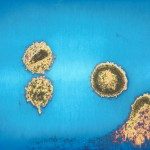Lien vers Pubmed [PMID] – 22691373
Retrovirology 2012;9:49
BACKGROUND: SAMHD1 is a nuclear protein that blocks lentiviral infection before reverse transcription in macrophages and dendritic cells. The viral accessory protein Vpx overcomes the SAMHD1-mediated lentiviral block by inducing its proteasomal degradation.
RESULTS: Here, we identified the nuclear localization signal (NLS) of SAMHD1, and studied its contribution to restriction of HIV-1 and SIVmac. By studying the cellular distribution of different SAMHD1 variants, we mapped the nuclear localization of SAMHD1 to residues 11KRPR14. Mutagenesis of these residues changed the cellular distribution of SAMHD1 from the nucleus to the cytoplasm. SAMHD1 mutants that lost nuclear localization restricted HIV-1 and SIV as potently as the wild type protein. Interestingly, SAMHD1 mutants that localized to the cytoplasm were not degraded by nuclear Vpx alleles. Therefore, nuclear Vpx alleles require nuclear localization of SAMHD1 in order to induce its degradation. In agreement, SIVmac viruses encoding Vpx did not overcome the restriction imposed by the cytoplasmic variants of SAMHD1.
CONCLUSIONS: We mapped the NLS of SAMHD1 to residues 11KRPR14 and studied the contribution of SAMHD1 nuclear localization to restriction of HIV-1 and SIV. These experiments demonstrate that cytoplasmic variants of SAMHD1 potently block lentiviral infection and are resistant to Vpx-mediated degradation. The nuclear Vpx alleles studied here are only capable of degrading a nuclearly localized SAMHD1 suggesting that Vpx-mediated degradation of SAMHD1 is initiated in the nucleus.

